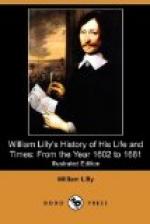so favourable an interpretation. His systematic
and successful attention to his own interest—his
dexterity in keeping on ’the windy side of the
law’—his perfect political pliability—and
his presence of mind and fertility of resources
when entangled in difficulties—indicate
an accomplished impostor, not a crazy enthusiast.
It is very possible and probable, that, at the outset
of his career, he was a real believer in the truth
and lawfulness of his art, and that he afterwards
felt no inclination to part with so pleasant and
so profitable a delusion: like his patron,
Cromwell, whose early fanaticism subsided into
hypocrisy, he carefully retained his folly as a cloak
for his knavery. Of his success in deception,
the present narrative exhibits abundant proofs.
The number of his dupes was not confined to the
vulgar and illiterate, but included individuals
of real worth and learning, of hostile parties and
sects, who courted his acquaintance and respected
his predictions. His proceedings were deemed
of sufficient importance to be twice made the
subject of a parliamentary inquiry; and even after
the Restoration—when a little more scepticism,
if not more wisdom, might have been expected—we
find him examined by a Committee of the House of
Commons, respecting his fore-knowledge of the
great fire of London. We know not whether
it ‘should more move our anger or our mirth,’
to see an assemblage of British Senators—the
cotemporaries of Hampden and Falkland—of
Milton and Clarendon—in an age which roused
into action so many and such mighty energies—gravely
engaged in ascertaining the causes of a great national
calamity, from the prescience of a knavish fortuneteller,
and puzzling their wisdoms to interpret the symbolical
flames, which blazed in the mis-shapen wood-cuts
of his oracular publications.
“As a set-off against these honours
may be mentioned, the virulent and unceasing attacks
of almost all the party scribblers of the day;
but their abuse he shared in common with men,
whose talents and virtues have outlived the malice
of their cotemporaries, and
’Whose honours
with increase of ages grow,
As streams
roll down, enlarging as they flow.’”
Retrospective Review,
Vol. ii. p. 51.]
The town of Diseworth did formerly belong long unto
the Lord Seagrave, for there is one record in the
hands of my cousin Melborn Williamson, which mentions
one acre of land abutting north upon the gates of the
Lord Seagrave; and there is one close, called Hall-close,
wherein the ruins of some ancient buildings appear,
and particularly where the dove-house stood; and there
is also the ruins of decayed fish-ponds and other
outhouses. This town came at length to be the
inheritance of Margaret, Countess of Richmond, mother
of Henry VII. which Margaret gave this town and lordship
of Diseworth unto Christ’s College in Cambridge,
the Master and Fellows whereof have ever since, and
at present, enjoy and possess it.




